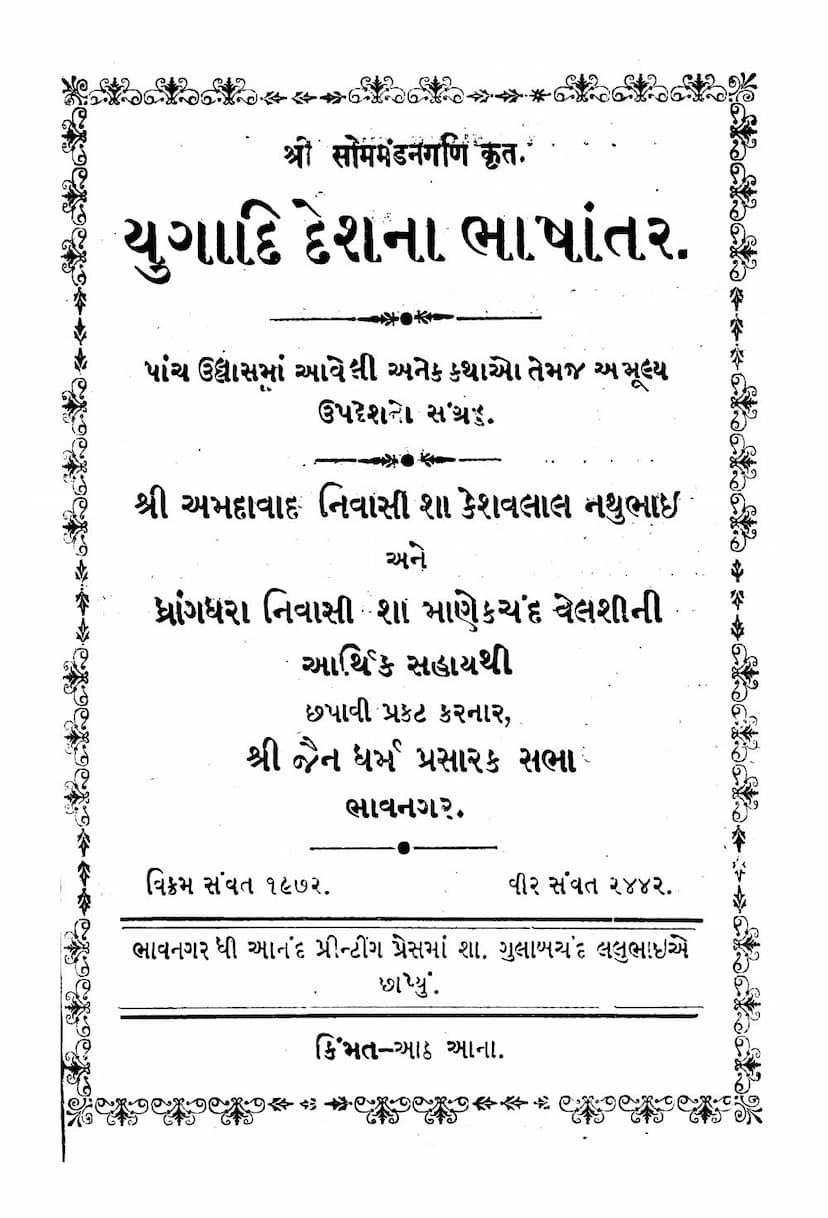Yugadi Deshna Bhashantar
Added to library: September 2, 2025

Summary
Here's a comprehensive summary of the Jain text "Yugadi Deshna Bhashantar" (Translation of Yugadi Discourse) by Sommandan Gani, based on the provided pages:
Title: Yugadi Deshna Bhashantar (Translation of Yugadi Discourse) Author: Sommandan Gani Publisher: Jain Dharm Prasarak Sabha, Bhavnagar Date: Vikram Samvat 1972 / Vir Samvat 2442
Overview:
"Yugadi Deshna Bhashantar" is a translation and adaptation of a Sanskrit work by Muni Sundar Suri, composed by Sommandan Gani. The book is divided into five "Ullasas" (sections or chapters) and contains numerous stories and invaluable teachings. The aim of this translation is to make the profound and impactful messages of the original work accessible to Gujarati readers. The publication was made possible through the financial support of Shri Keshavlal Nathubhai of Ahmedabad and Shri Manekchand Velshi of Dhrangadhra, intended for the spiritual benefit of their deceased sons.
Core Theme and Structure:
The central theme of the book is to explain the consequences of attachment to worldly desires and emotions, particularly the five major attachments: Kashaya (passions), Moh (attachment/delusion), Lakshmi (wealth), Stri (women/sensual pleasures), and Rajriddhi (royal power). The author, Sommandan Gani, meticulously illustrates these concepts through narratives in each of the five Ullasas, supported by compelling examples.
Summary of Each Ullasa:
-
First Ullasa: Focuses on the detestable nature of the four Kashayas: Krodh (anger), Maan (pride), Maya (deceit), and Lobh (greed). It begins with an episode involving Bharata's 98 brothers who are distressed by Bharata's summons. Bhagwan Rishabhdev advises them on the renunciation of these Kashayas, using the detailed example of a family consumed by anger and other passions. The Ullasa also includes the story of Kamalakshmi, illustrating how attachment to sensual pleasures leads to repeated cycles of birth and death.
-
Second Ullasa: Deals with the detestable nature of attachment (Moh). It presents the effective example of five types of sons (Abhavya, Durubhavya, Bhavya, Aasannasiddha, and Tadbhavasiddhika) to demonstrate the consequences of attachment. The Ullasa further elaborates on achieving happiness through detachment and misery through excessive attachment, using the stories of Saraswati, Devadin, and Priyangu Seth. It concludes with the story of Dhanshri, showing that even religious discourse is useless for those suffering from attachment, highlighting the pain caused by clinging to worldly possessions.
-
Third Ullasa: Focuses on the detestable nature of wealth (Lakshmi). It uses the story of Ratnakar Seth, who considered wealth extremely dear, to illustrate this point. Following this, it presents narratives of those who rejected Lakshmi, worshipped her, hoarded her, and generously spent her, namely Shuchiya, Shridev, Sanchayshal, and Bhangdev, effectively demonstrating the varied outcomes associated with wealth.
-
Fourth Ullasa: Addresses the detestable nature of sensual desires (Vishaya), with a particular emphasis on touch (Sparshana). It uses the impactful example of Sundar and Sundari, the son and daughter of a merchant, related to the subject of touch. Subsequently, it highlights the fickle nature of women through the story of Patal Sundari and the deeply attached Bahudhanya, illustrating the perils of excessive attachment. The Ullasa concludes with Bhagwan's profound teachings to the 98 sons, which leads them to renounce the world and embrace asceticism, achieving omniscience in a short period.
-
Fifth Ullasa: Recounts the famous story of Bharata and Bahubali. It describes Bharata's remorse, his visit to Bhagwan, his desire for monastic charity, Bhagwan's explanation of "Avagraha" (a ritualistic pause), Bharata's initiation of "Swamivatsalya" (care for others), and its consequences. The narrative details the events leading to the conflict between Bharata and Bahubali, the diplomatic efforts, the ensuing battle, the five types of combat (Drishtiyuddha, Vagyuddha, Bahuyuddha, Mushiyuddha, and Dandayuddha), Bharata's defeat in all five, his remorse, and his subsequent renunciation of the chakra. It culminates in Bahubali's renunciation of his hair, attainment of asceticism, the pride he initially felt, his contemplation while standing, the advice of Brahmisundari, his achievement of omniscience, the simultaneous nirvana of 108 great beings including Bhagwan, Bharata's attainment of omniscience in his second life, and the liberation of both Bharata and Brahmisundari.
Key Takeaway and Recommendation:
The book is highly praised for its profound insights and compelling narratives, making it difficult to put down once started. Readers are encouraged to read it from beginning to end to truly grasp its beauty and benefit from the author's diligent efforts. The introduction concludes with a call to action for readers to complete the book and thus validate the publication's purpose.
Overall Significance:
"Yugadi Deshna Bhashantar" serves as a valuable spiritual guide within the Jain tradition, using relatable stories and clear explanations to impart fundamental teachings on detachment, the consequences of attachment, and the path to spiritual liberation. The charitable intent behind its publication underscores its purpose as a means of spiritual upliftment for the community.